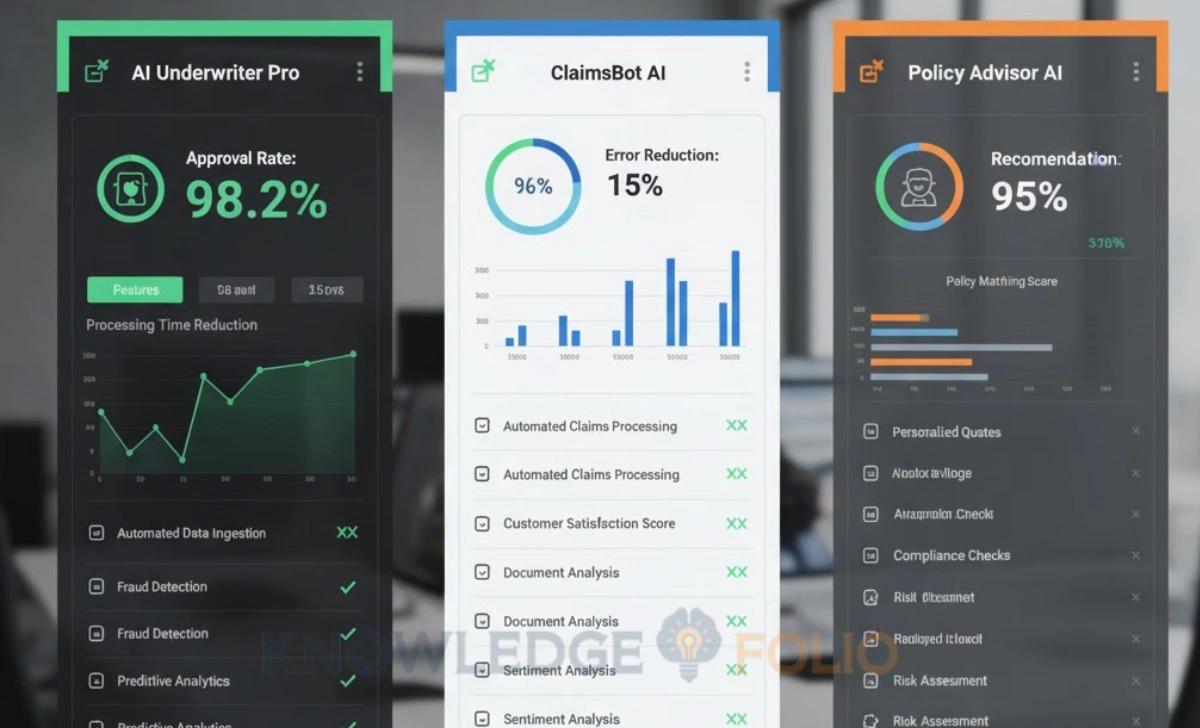The best AI tools for insurance in 2025 include V7 Go for document automation, hx Renew for pricing models, Expert.ai for NLP-driven claims processing, CloudTalk for customer communications, and Knowmax for knowledge management. Evaluate tools based on integration ease, efficiency metrics (decision time, error rates), compliance features, and proven ROI in insurance-specific use cases.
Insurance professionals and technology leaders face a critical challenge in 2025—cutting through the noise to identify which AI tools for insurance actually deliver measurable results. The market is flooded with platforms promising transformation, but not all solutions integrate smoothly with legacy systems, meet regulatory requirements, or prove their value in real-world insurance workflows.
The stakes are high. Choose the wrong tool and you risk workflow disruption, data silos, wasted budget, and vendor lock-in. Choose the right one and you can slash underwriting decision times, automate claims processing, detect fraud faster, and improve customer satisfaction—all while maintaining compliance and accuracy.
This guide provides a practical comparison of the leading AI platforms for insurance automation in 2025. You’ll learn which tools excel at underwriting, claims, risk analytics, and customer engagement—plus a framework to evaluate any solution against your specific needs. Whether you’re a CTO planning your tech stack or an operations leader seeking efficiency gains, you’ll leave with actionable insights to make the right choice.
Why Selecting the Right AI Tool Matters in Insurance Automation
Tool selection in insurance isn’t like choosing software for other industries. Insurance operates under strict regulatory oversight, handles sensitive personal data, and relies on accuracy that directly impacts people’s financial security. A misconfigured AI tool can approve risky policies, delay legitimate claims, or create compliance violations that trigger regulatory sanctions.
Integration challenges compound the selection difficulty. Most insurers run on legacy policy administration and claims systems that weren’t designed for AI integration. A tool that can’t connect to your core systems creates manual workarounds that negate automation benefits. You need solutions with robust APIs, pre-built connectors, and proven track records integrating with insurance technology stacks.
Performance metrics matter enormously. In insurance, “AI-powered” is meaningless without quantifiable improvements—how much faster are underwriting decisions? What’s the error rate reduction? How many false fraud alerts does it generate? The best tools provide clear efficiency benchmarks and case studies from insurance implementations, not generic AI capabilities.
The Cost of a Mismatched Tool
Deploying the wrong AI solution carries hidden costs that extend far beyond the licensing fees. Workflow disruption occurs when the tool doesn’t align with how underwriters, claims adjusters, or agents actually work. Staff resist adoption, workarounds proliferate, and efficiency gains evaporate.
Data silos emerge when the AI tool can’t share information with your policy, claims, and customer systems. You end up maintaining parallel datasets, creating reconciliation headaches and increasing error risk. Worse, you can’t leverage the full value of your data when it’s trapped in disconnected systems.
Vendor lock-in becomes a serious concern if you build processes around a proprietary platform with limited export capabilities. Switching costs balloon—requiring data migration, workflow redesign, and staff retraining. Some vendors deliberately make exit difficult to maintain subscription revenue even when the tool underdelivers.
Regulatory risk increases when AI tools lack proper audit trails, explainability features, or bias monitoring. Australian regulators (ASIC, APRA) are scrutinising AI use in financial services. A tool that can’t demonstrate fair, transparent decision-making creates compliance exposure that could trigger investigations or fines.
Key Efficiency and Integration Criteria
When evaluating AI tools for insurance, prioritise these technical and operational factors:
- Speed metrics: How much does the tool reduce decision time for underwriting, claims processing, or fraud review? Look for specific benchmarks—”reduced from 3 days to 12 minutes” is meaningful; “improves efficiency” is not.
- Accuracy improvements: What’s the error rate compared to manual processes or rule-based systems? Does it reduce false positives in fraud detection? How often do human reviewers need to override AI decisions?
- Integration capabilities: Does it offer REST APIs, pre-built connectors for major insurance platforms (Guidewire, Duck Creek, Applied Epic), or flexible data ingestion? Can it handle your data formats without extensive preprocessing?
- Compliance features: Does it provide audit logs, model explainability, bias monitoring, and regulatory reporting? Can you demonstrate to auditors how the AI reached specific decisions?
- Scalability and performance: Can it handle your transaction volumes during peak periods (renewal season, post-disaster claims spikes) without degrading? What’s the infrastructure overhead?

Top Categories of AI Tools for Insurance Automation in 2025
Before diving into specific platforms, understand the major categories and where each type delivers value in insurance operations. Most insurers need multiple tools serving different functions rather than a single “do-everything” platform.
The insurance value chain has distinct phases—prospecting and quoting, underwriting and binding, claims processing, customer servicing, and risk management. AI tools typically specialise in one or two phases, though some enterprise platforms attempt broader coverage. Your tool selection should map to your highest-priority improvement areas.
Underwriting and Quoting Engines
These tools accelerate risk assessment and pricing by automating data gathering, running predictive models, and generating quotes. They ingest applications, pull external data sources (credit, property records, telematics), evaluate risk factors using machine learning, and output pricing recommendations or straight-through decisions.
Leading underwriting AI platforms integrate with rating engines and policy administration systems, allowing instant quote generation. They’re particularly valuable for high-volume personal lines (auto, home) where manual underwriting is economically unviable for smaller policies. Some also handle complex commercial risks by surfacing relevant precedents and suggesting risk improvements.
The best quoting software combines speed with accuracy. In 2025, advanced platforms can generate comprehensive quotes in under two minutes while maintaining pricing discipline. They also provide underwriters with clear explanations of why the AI recommended specific pricing or declined coverage, supporting both quality control and regulatory compliance.
Claims Automation and Fraud Detection Platforms
Claims processing involves repetitive tasks—data entry, document verification, damage assessment, coverage checking, settlement calculation—that are ideal for automation. AI tools in this category use computer vision to evaluate damage photos, NLP to extract information from medical records or police reports, and machine learning to detect anomalies suggesting fraud.
Document automation tools are particularly valuable for insurers drowning in paperwork. They automatically classify incoming documents (medical bills, repair estimates, incident reports), extract key data fields, and route them to appropriate workflows. This eliminates manual data entry and reduces processing time from days to hours.
Fraud detection platforms analyse claim patterns across your portfolio, flagging suspicious cases for investigation. They identify subtle indicators—billing anomalies, provider networks, timing patterns—that rules-based systems miss. The best solutions integrate with claims systems to provide real-time scoring as adjusters work, not batch processing that delivers insights too late.
Customer Engagement and Lead Management AI
These tools focus on the customer-facing side of insurance—lead qualification, policy servicing, renewal management, and support. AI chatbots handle routine inquiries 24/7, freeing agents for complex interactions. Virtual assistants guide customers through claims filing or policy changes, reducing call centre volume.
AI-powered CRM systems help agents prioritise leads based on conversion probability, recommend coverage options based on customer profiles, and automate follow-up sequences. They integrate with communication platforms (email, SMS, phone) to orchestrate multi-channel engagement campaigns.
In 2025, the most sophisticated customer engagement tools use sentiment analysis to detect frustrated customers and escalate to human agents before complaints escalate. They also provide agents with real-time guidance during calls—surfacing relevant policy details, suggesting responses to objections, and recommending cross-sell opportunities.
Spotlight on 5 Standout AI Tools for Insurance Automation
Based on 2025 performance data, integration capabilities, and insurance-specific features, these platforms stand out. Each excels in particular use cases, so match your selection to your priority needs.
V7 Go – Document and Underwriting Automation
V7 Go specialises in processing unstructured data—images, PDFs, handwritten forms—that traditional OCR struggles with. It uses advanced computer vision and NLP to extract structured data from insurance documents, making it ideal for digitising legacy files or automating intake processes.
- Target use case: Underwriting automation, particularly for commercial lines where applications arrive as scanned documents, photos of properties, or broker-submitted PDFs. Also valuable for claims teams processing repair estimates, medical records, or incident documentation.
- Integration capabilities: Open API architecture allows connection to major policy and claims systems. Supports batch processing for backlog digitisation or real-time processing for new submissions. Can push extracted data directly into downstream workflows without manual intervention.
- Efficiency metrics: Insurers report 80% reduction in data entry time and improved accuracy (fewer transcription errors). One case study showed underwriting decision time dropped from 48 hours to 4 hours by eliminating manual document review bottlenecks.
Pros: Highly accurate on diverse document types, flexible deployment (cloud or on-premise), strong security features for sensitive data.
Cons: Requires initial training period to optimise for your specific document formats, higher pricing than simpler OCR solutions.
hx Renew – Pricing and Underwriting Model Acceleration
hx Renew focuses on the actuarial and pricing side of underwriting. It automates model building, testing, and deployment—work that traditionally takes actuarial teams months. Insurers use it to develop and refresh pricing models faster, enabling more responsive rate adjustments.
- Target use case: Insurers needing to modernise pricing models, launch new products quickly, or respond to market changes with updated rates. Particularly valuable for personal lines carriers competing on price accuracy and speed to market.
- Integration capabilities: Connects to actuarial data warehouses and rating engines. Exports models in formats compatible with standard insurance platforms. Includes version control and testing frameworks to maintain model governance.
- Efficiency metrics: Vendors claim up to 75% reduction in model build time—taking projects from 6 months to 6 weeks. This allows more frequent model updates, improving pricing accuracy as loss patterns evolve.
Pros: Dramatically accelerates actuarial work, built specifically for insurance pricing use cases, strong documentation for regulatory review.
Cons: Requires actuarial expertise to operate effectively, significant investment for smaller carriers, benefits mainly realised at scale.
Expert.ai – NLP Solution for Policy and Claims Document Processing
Expert.ai brings natural language processing capabilities tuned for insurance language. It understands insurance-specific terminology, policy structures, and claim narratives—extracting key information more accurately than general-purpose NLP tools.
- Target use case: Automating review of policy documents to extract coverage terms, exclusions, and limits. Also used in claims to process adjuster notes, medical records, legal filings, and identify coverage issues automatically.
- Integration capabilities: API-first design allows embedding in existing workflows. Pre-built insurance domain models accelerate deployment. Supports multiple languages for international insurers.
- Efficiency metrics: Claims teams report 60% faster document review, allowing adjusters to handle more cases. Reduces coverage disputes by flagging potential issues early in the claims process.
Pros: Insurance-specific language understanding, handles complex policy language accurately, continuous learning improves over time.
Cons: Best results require feeding it sufficient volume of your documents for tuning, may need customisation for non-standard policy forms.
CloudTalk – AI-Powered Communications Platform for Insurers
CloudTalk handles the communications layer—phone, SMS, email integration—with AI-driven routing, transcription, and analytics. It’s designed for insurance sales and service teams managing high call volumes with the need for quality monitoring and compliance recording.
- Target use case: Call centres handling sales, policy servicing, and claims inquiries. AI routes calls to agents with relevant expertise, transcribes conversations for compliance records, and analyses sentiment to identify coaching opportunities.
- Integration capabilities: Integrates with major CRM and policy systems to provide agents with screen pops showing customer context. APIs allow triggering outbound campaigns from your systems.
- Efficiency metrics: Insurers report 30% improvement in first-call resolution and 25% reduction in average handle time through better routing and agent guidance.
Pros: Easy setup for call centre teams, strong analytics and reporting, compliance-friendly recording and archiving.
Cons: Value primarily for phone-heavy operations, limited benefits for digital-first insurers, subscription costs scale with user count.
Knowmax – Knowledge Management AI for Insurance Agents
Knowmax functions as an intelligent knowledge base, surfacing relevant information to agents as they work. It learns which articles, procedures, or policy details agents need for specific situations and proactively presents them—reducing search time and improving accuracy.
- Target use case: Supporting agents and underwriters who need quick access to policy details, underwriting guidelines, claims procedures, or product information. Especially valuable for multi-product carriers where agents can’t memorise everything.
- Integration capabilities: Embeds within existing agent desktop tools, CRM systems, or policy platforms. Can integrate with content management systems to automatically update as guidelines change.
- Efficiency metrics: Agents report 40% reduction in time spent searching for information, leading to faster customer interactions and fewer errors from applying outdated guidance.
Pros: Improves agent productivity without replacing existing systems, relatively low implementation complexity, continuous improvement as AI learns usage patterns.
Cons: Requires maintaining quality knowledge base content (garbage in, garbage out), benefits depend on agent adoption, may overlap with existing knowledge tools.

How to Compare AI Tools for Insurance Automation—A Practical Evaluation Framework
Use this structured approach to evaluate any AI tool against your requirements. This framework ensures you’re comparing apples to apples and focusing on factors that actually impact success in insurance environments.
Integration and Legacy Stack Compatibility
Start by mapping your current technology landscape—what policy administration, claims, billing, CRM, and data warehouse systems do you run? List the integration points where the AI tool will need to connect. Then evaluate each candidate:
- API availability and quality: Does the vendor provide well-documented REST or SOAP APIs? Are they stable (versioned with backward compatibility) or do updates break integrations?
- Pre-built connectors: Are there existing integrations with your core systems (Guidewire, Duck Creek, Applied, QQCatalyst)? Pre-built connectors accelerate deployment and reduce integration risk.
- Data format flexibility: Can the tool ingest data in your existing formats (XML, JSON, CSV, EDI) or do you need data transformation middleware?
- Authentication and security: Does it support enterprise authentication (SSO, SAML) and meet your data security requirements (encryption, access controls, audit logs)?
- Deployment options: Can you deploy on-premise if regulatory or data sovereignty requirements prevent cloud hosting? Is hybrid deployment possible?
- Practical tip: Request a technical proof of concept focused specifically on integration with your core systems. Generic demos don’t reveal integration challenges that emerge with real data and workflows.
Efficiency Metrics and Proof Points
Demand specific performance data from insurance implementations, not generic AI capabilities. Useful metrics include:
Time reduction: How much faster are processes compared to current state? Look for concrete numbers—”reduced underwriting from 3 days to 12 minutes” beats “significantly faster.”
Accuracy improvements: What’s the error rate? For fraud detection, what’s the false positive rate (legitimate claims flagged incorrectly)? For underwriting, how often do humans override AI decisions?
Volume handling: How many transactions can it process per hour? Does performance degrade under load? This matters during peak periods like renewal season or post-disaster claims surges.
User productivity: How much time do agents or adjusters save per transaction? Does it reduce average handle time, increase throughput, or improve first-call resolution?
ROI timeline: How quickly do efficiency gains offset licensing and implementation costs? Look for case studies showing payback periods under 18 months for typical implementations.
Request these from vendors:
- Case studies from similar-sized insurers in your lines of business
- Benchmark data comparing before/after performance
- Customer references you can contact directly
- Trial or pilot programs to test with your actual data and workflows
Governance, Compliance, and Bias Mitigation
Insurance AI tools must support regulatory compliance and ethical AI practices. Australian insurers face scrutiny from ASIC and APRA regarding algorithmic decision-making. Evaluate these governance capabilities:
- Audit trails: Does the tool log all decisions, data inputs, and model versions? Can you produce a complete record for regulatory review or customer disputes?
- Model explainability: Can it explain individual decisions in plain language? This is crucial for declining coverage or adjusting premiums—customers and regulators demand transparency.
- Bias monitoring: Does it include tools to test for disparate impact across protected demographics? Can you demonstrate the AI doesn’t discriminate based on age, gender, location, or other protected characteristics?
- Human oversight mechanisms: Can you configure approval workflows requiring human review for high-stakes decisions or edge cases?
- Regulatory reporting: Does it support compliance reporting requirements (e.g., claims handling timeframes, underwriting decision documentation)?
Data privacy: Is it compliant with Australian Privacy Principles? Does it support data subject access requests and right-to-erasure obligations?
Checklist for governance evaluation:
- Request documentation of the vendor’s AI ethics framework and bias testing procedures
- Verify the tool can export complete decision logs for audit purposes
- Test explainability features with sample decisions from your domain
- Confirm data handling complies with Privacy Act and industry regulations
- Establish clear protocols for when human review overrides AI recommendations
Implementation Considerations Beyond Tool Selection
Choosing the right tool is only half the battle—successful implementation requires thoughtful planning and change management.
- Start with a pilot program: Don’t roll out enterprise-wide immediately. Choose a contained use case (e.g., one product line, one regional office) to prove value and identify integration issues. Set clear success metrics upfront and measure rigorously.
- Invest in change management: AI tools fail when users resist adoption. Involve agents, underwriters, and adjusters early in selection and pilot phases. Provide comprehensive training and support. Address concerns about job displacement honestly—emphasise how AI handles repetitive work so staff can focus on complex, rewarding cases.
- Plan for data quality: AI is only as good as the data it trains on. Before implementation, audit data quality in your source systems. Clean duplicates, standardise formats, and fill critical gaps. Poor data quality is the number one cause of underwhelming AI results.
- Establish governance early: Create an AI oversight committee with representation from operations, legal, compliance, IT, and data science. Define approval processes for model updates, decision-override protocols, and escalation procedures for edge cases or disputed outcomes.
- Budget for ongoing optimisation: AI tools require continuous tuning as business conditions evolve. Plan for regular model retraining, performance monitoring, and adjustments. Factor ongoing costs (subscriptions, infrastructure, staff time) into ROI calculations.
Conclusion
Choosing the best AI tools for insurance automation in 2025 isn’t about chasing the latest technology trends—it’s about finding solutions that integrate seamlessly, deliver measurable efficiency gains, and meet regulatory requirements. The platforms highlighted here excel in specific insurance use cases, from document processing to pricing models to customer communications.
Use the evaluation framework to assess tools systematically against your integration capabilities, efficiency needs, and governance requirements. Don’t rely solely on vendor claims—demand proof points from insurance implementations, conduct technical pilots, and verify compliance capabilities with your legal and compliance teams.
Start small with a high-impact use case where AI can deliver clear ROI within 12–18 months. Whether that’s accelerating underwriting decisions, automating claims document processing, or improving fraud detection, prove the value before scaling. The insurers succeeding with AI in 2025 are those that implement deliberately, measure rigorously, and iterate continuously.
Call to Action: Ready to explore AI automation for your insurance operations? Begin with the evaluation checklist above, identify your highest-priority pain point, and pilot one tool that directly addresses it. Have experience with any of these platforms or questions about implementation? Share your insights in the comments—we’d love to hear what’s working in real-world insurance environments.



